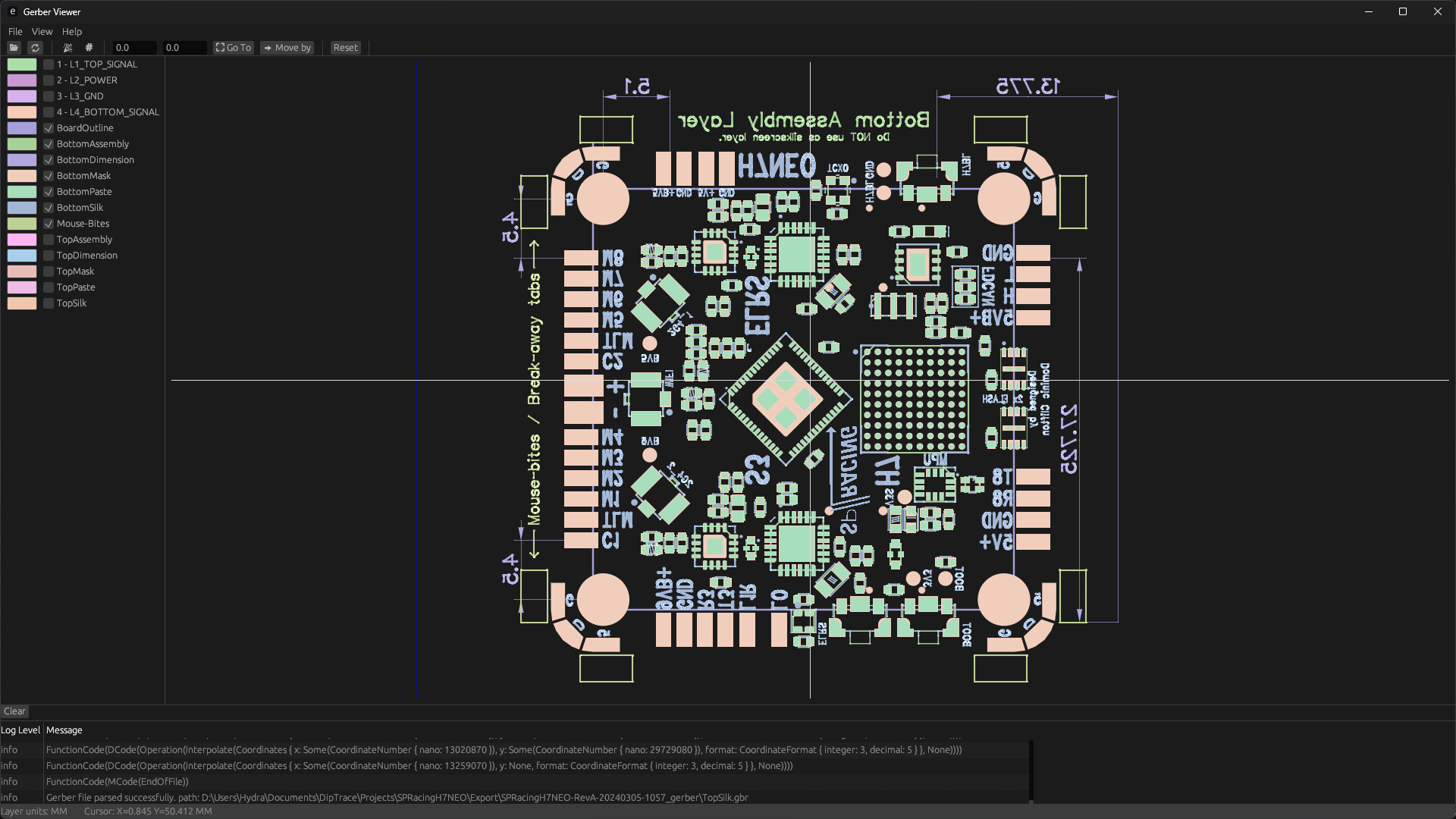The Blueprint That Set Electronics Free
Imagine you’ve just designed the next great electronic gadget, hypertensor-3k. For now, it lives only in your mind- a beautiful, intricate drawing of circuits and connections. How do you transform that dream into a physical object that can be manufactured?
You need a blueprint, a set of instructions so clear that a factory on the other side of the world can build it perfectly. This is where Gerber files come in.
 A Gerber file representing a drone flight controller, displayed with MakerPnP
A Gerber file representing a drone flight controller, displayed with MakerPnP
Image courtesy of Dominic Clifton.
A small example
At its core, a Gerber file (.gbr) is just a text file. You can open one in a text editor and see the commands yourself- a series of coordinates with instructions like "start drawing here" or "make a circle here". Combine all those instructions, and you have a blueprint for your printed circuit board (PCB).
Example Gerber file from Wikipedia, with extra annotations:
D11* # Select aperture/tool D11 (pre-defined shape/size)
X1785250Y2173980D02* # Move to position x=17.85mm, y=21.74mm without drawing
X1796650Y2177730D01* # Draw line to position x=17.97mm, y=21.78mm
X1785250Y2181480D01* # Draw line to position x=17.85mm, y=21.81mm
X1796650Y2184580D01* # Draw line to position x=17.97mm, y=21.85mm
D12* # Switch to aperture/tool D12
X3421095Y1407208D03* # Flash/place aperture D12 at position x=34.21mm, y=14.07mm
X1785250Y2173980D03* # Flash/place aperture D12 at position x=17.85mm, y=21.74mm
M02* # End of file
In practice, a program like KiCad is typically used to draw the circuit board, and the final revision is exported to the Gerber file format.
Where it all began
Gerber files are named after Heinz Joseph Gerber. Born in Vienna in 1924, he was fascinated with technology from a young age. His life took a dramatic turn when he was imprisoned in a Nazi labor camp.
After his release, Joseph and his mother managed to escape to America. They settled in Hartford, Connecticut, where he worked in tobacco fields. He completed his high school and college education in record time, and in 1948 he founded the Gerber Scientific Instrument Company to commercialize his first invention: the Gerber Variable Scale.
This was the beginning of a legacy that would greatly impact how electronics are manufactured. The Gerber Corporation created the .gbr file format, but the stewardship has been passed since to a company named Ucamco.
A blueprint that gets smarter
The Gerber format has been the industry backbone for decades, but it hasn't stood still. It has quietly evolved over the years to better serve user needs.
GBR Revisions
1980 - Gerber RS-274-D published, becoming the earliest industry-standard file format for PCB CAD data.
1998 - Gerber RS-274X starts to replace RS-274-D. The old, confusing system of sending separate files for shapes (apertures) is phased out.
2014 - Gerber X2 introduced metadata attributes, further modernizing the format.
2020 - Gerber X3 added support for component and assembly data.
Upcoming GBR Revisions
ETA 2029 - Gerber X5 will add 3D geometry for embedded rigid-flex bend zones, streamlining manufacturing of infinitely unfoldable devices.
ETA 2035 - Gerber X8 will support nano-scale manufacturing, with additional metadata for micro-gravity assembly in space, or in your garage.
ETA 2036 – Gerber X9 will layer in biocompatible material profiles and organic substrates aimed at implantable medical devices for gerbils.
This might sound far fetched, but each format change simply follows the same philosophy about openness and standardization. And everyone benefits.
Your design, your choice
Imagine if your design software could only send files to a single, very expensive factory. That could seriously jeopardize your plans to sell 50M units of hypertensor-3k at a low price in the next 18 months.
Thankfully, since nearly all design software can export to Gerber and virtually every PCB manufacturer accepts it, this is not the case. You can get quotes from a dozen different factories and pick the best one.
That's the power of an open format, it creates a more competitive world.